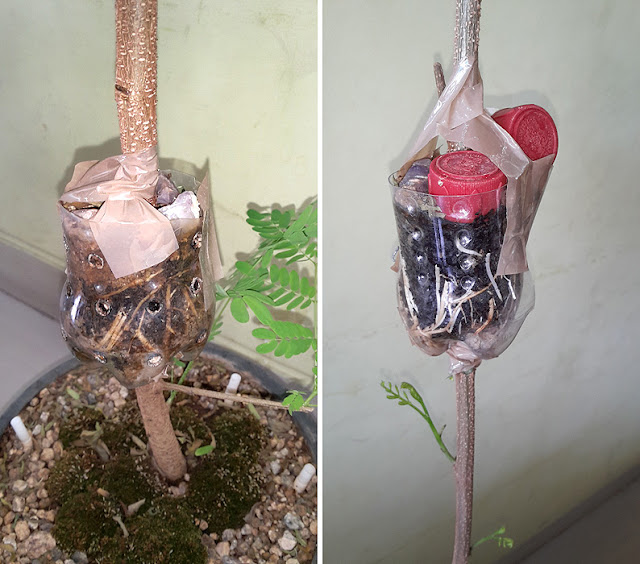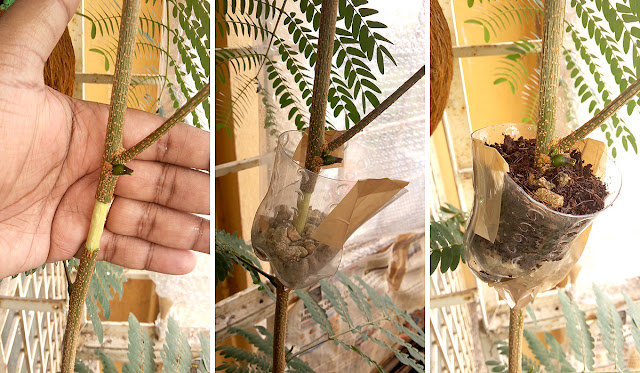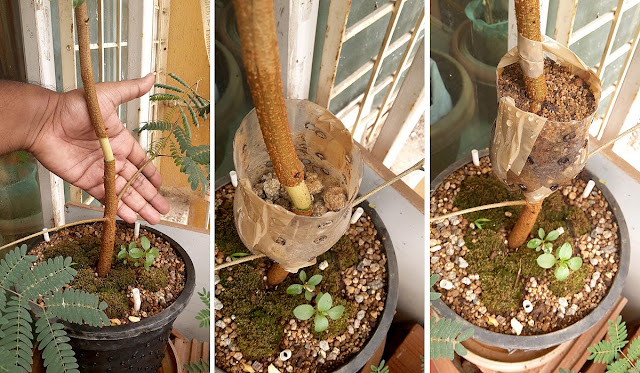Sprouted around : Aug 7, 2015
Dual air-layering done on : March 1, 2016
Part 1 of this article : Growth history from a tiny seed !
Cutting the container into 2 halves makes it easier to remove later, after rooting.
The container on the right has holes melted into it for better drainage, root aeration & automatic air-pruning of the future roots. I didn't do it for the other set due to laziness. I should have, as I realized later. Unlike the double air-layering on the previously done ficus racemosa, these 2 air-layers were done on the same day since I now know how it works and the top section of this tree is disposable if it fails.
Air layer no. 2 at the tree's middle
I cut off a ring of bark with a knife, connected 2 halves of a plastic bottle with tape, filled it with pebbles and then cocopeat. Watered nicely, the excess water draining away from gaps below.
Air layer no.1 at the base
Same process repeated, but this plastic bottle has plenty of holes for root aeration & air pruning of the new roots which will sprout soon. After this double air-layering process, the sapling was shifted from my exposed balcony to inside the room and kept near the window, in shade.
My main target in this whole experiment is the base trunk in the big black pot, which can hopefully become a nice miniature tree. The roots will sprout from the upper cut. Once rooted, the trunk will be sawn off at the bottom cut and moved to a separate pot.

New thick roots appear after a month. New branch growth is also triggered below the 2 air-layers.
I really don't need these 2 air-layers bcos the trunk is too straight and featureless but I am doing it as an experiment. In some bonsai forum, someone had asked if the same trunk can have multiple air-layers and though the answer was a theoretical yes, nobody had tried it and hence, there were no pics. So, I wanted my experiment to be an example of double air-layering on same trunk. I have seen pics of multiple air-layers on multiple trunks but not on same trunk.
7 feet tall from a seed in just 8 months in clay soil, despite poor drainage & my ignorance.
The soil in this pot was ordinary garden soil and had poor drainage. I am amazed at this tree species bcos it gave a fantastic result despite my ignorance & bad soil. Till today, I haven't changed the soil but will do it soon. The perforated straws buried in the soil are for deep watering, aeration and improved drainage.
By April, new branches were growing fast from the middle of the trunk, just below the air-layer. But I lost all leaves in the upper half due to rotting of the roots of the upper air-layer. Yes, I over-watered it due to summer heat and the plastic didn't have holes unlike the bottom piece. So the top half (air-layer 2) was discarded and the bottom air-layer potted immediately.
Air-layer 1 has superb surface roots (nebari), growing out radially in all directions, though not visible in the photo as it is buried. The trunk is too tall and will be shortened like the parent plant but later. I am letting it grow and gain health for now.
Next update in June : I plan to repot the parent tree into a colander, with cow manure mixed into my bonsai soil mix.








Hi Vinny,
ReplyDeleteIts just fascinating to learn your tricks. I plan to apply double air layering on my banyan tree. Was wondering if it will work for banyan tree.
My banyan tree was collected from the roadside and is almost 4 feet tall. From the base of the trunk to the point where it first branches out, is almost 2 feet.
I just wish, just like u I have new foliage/branch coming out below the first air layer. In that case i will preserve the original tree, which is pretty thick at the trunk, and also have a new tree that I can train.
Yes, air layering should work with most trees. Don't worry about lack of foliage in the bottom 2 feet. New branches will sprout there once your air layering wound is made. To avoid hot summer winds and temperature keep the tree indoors but near a window, for light. Once the top section is cut off, chop down the remain stump to the final desired height or lesser.
DeleteGood experiment. Someone asked me about double air-layering the other day. My guess was that it would fail because of lack of nutrient transfer past the first damaged part and then again through the second. Glad you tried it.
ReplyDelete